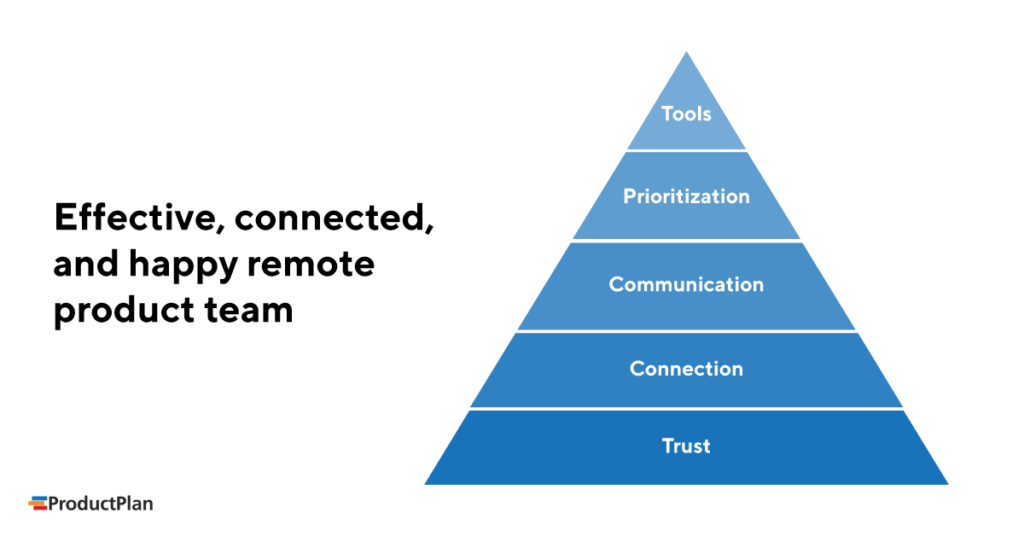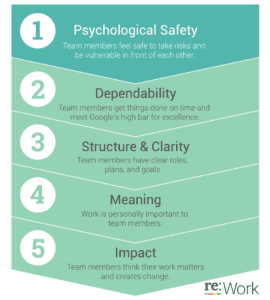5 Key Responsibilities of Intentional Leadership of a Remote Product Team
As many people have come to realize in recent weeks, remote work involves quite a bit more than a simple change in location. Remote work actually requires a significant shift in views and experience of the traditional ways of working, thinking, and even leading.
It probably comes as little comfort to know that established remote teams who transitioned to remote work environments pre-pandemic experienced many of the same pains and challenges as those forced to work from home without much planning or preparation. The upside is that newly remote teams can learn quite a lot from seasoned remote-work pioneers.
At ProductPlan, we’ve been refining our approach to remote work for quite a few years. Along the way, we’ve made our fair share of mistakes. We’ve also had the luxury of time to ponder what it means to be remote and fine-tune our approach.
Watch our webinar to see our journey to building a connected and happy distributed product team:
First and foremost, what we’ve gleaned from our experiences is that there are all kinds of ways to go wrong with remote work and leading remote teams.
If you find yourself suddenly managing a remote product team (or even if you’ve been doing this very thing for a while now), what do you need to do to enable your people to be effective, connected, and happy?
5 Key Responsibilities of Intentional Leadership of a Remote Product Team
Let’s explore five key challenges a remote product team will likely encounter and how a product leader can transform those challenges into opportunities to pivot to a whole new way of working.

1. Trust your team to do their best work
Every relationship, whether personal or professional, requires trust to flourish.
Our first remote team was small, and everyone knew one another very well. Since strong relationships were already established before going remote, trust was a given. As our remote team grew, however, the “trust as a given” approach didn’t scale. Micromanagement crept in, which made everyone miserable.
What we discovered from this painful experience is that we have to be intentional about things like trust and communication, especially with remote teams.

Sure, letting go of control can be a significant challenge for product leaders, particularly when transitioning from a shared onsite work environment to a distributed work environment. Is the work getting done when you can’t see it happening? Some managers might feel inclined to overcorrect the lack of visual proof positive by micromanaging. This tendency can quickly turn toxic for remote teams because it’s more likely to build resentment rather than trust. It sends a strong message that you don’t trust your people or believe they are capable of accomplishing their objectives when out of sight.
By all means, check in on your people—just avoid checking up on your people. Establish clear objectives and regular check-ins–then let them do their work. The proof is in the pudding on this one, or preferably in their output.
Read Jim Semick’s tips for embracing uncertainty.
When Google’s People Operations (the company’s version of HR) set out to identify the key traits of a successful team, psychological safety topped the list.

Trust and safety together, open the door for people on your team to take risks and be vulnerable. This is the sweet spot where great ideas take root and grow.
Create a safe space for your team to thrive by empowering your people to do whatever it is that makes them happy and engaged without the fear of getting in trouble.
2. Create meaningful connection at every opportunity
Without the proverbial water cooler, how do you create meaningful connections with a remote team?
A knee-jerk reaction might be to schedule a meeting. While a meeting does connect people, creating a meaningful connection between people takes a little more effort and intention.
First of all, you don’t manage a bunch of robots. You manage people. Therefore, remember to humanize your interactions. Maybe allow five minutes at the beginning of a meeting for people to chat about non-work stuff, like what they had for lunch, the latest news, or their cat’s silly antics. Encourage your team to be human together by making space for it. These are the magical “water cooler” moments of a traditional office environment.
Establish regular check-ins to motivate your people and let them know you are there for them. Come right out and say that you don’t want to micromanage your team. Figure out—as a team—what you want to accomplish.
Here are a few ways to humanize interactions and create opportunities for meaningful connection:
- Slack isn’t just for business. It’s okay to have a little fun. Encourage your team to use the status to let the team know when they are walking the dog or eating lunch.
- Throw in a few ice breakers before jumping into a meeting (e.g., “Tell me something odd that happened this week.”).
- Add jokes, karaoke, or quick online games to the mix.
- Invite team members to give a brief desk tour once a week.
- Remember show and tell? We never outgrow our desire to share a detail or two about our lives and interests.
- How about a weekly coffee chat, yoga practice, or trivia happy hour? Think about the things that bring joy to your team and create space for them to share and enjoy together.
Seize opportunities to meaningfully connect with your team and enable your people to connect meaningfully. Look for new opportunities you haven’t considered before. Humanize your interactions whenever possible.
3. Put a premium on effective communication
In remote work environments, so much rides on communication. Get it right, and you’ll strengthen your team, create happier workers, and ultimately build excellent products. Get it wrong, and organizations, people, and products will fall apart.
Keep in mind this is going to feel different as a remote team.
First, define what you want to accomplish as a team. Start by asking: How do we want to work together? Don’t be afraid to let your team know that you are there for them. This will also support your intentional efforts to build trust.
As you strive to establish strategic, clear, and timely communication, explore what fits your team best. One size certainly does not fit all when it comes to the nuances and needs of your particular team.
Once you have the communication channels that fit your team, keep those channels streamlined to avoid unnecessarily burdening your people.
InVision, which boasts one of the largest fully remote teams, developed this strategic set of communication tools to help people stay positive and productive.
There is a tendency to solve remote problems with non-remote solutions. Meetings are an excellent example of this phenomenon. Virtually cramming everyone in the room is a common reaction when everyone is remote. Intentionally design meetings with your team. Before setting up a meeting (or when evaluating the benefits of current meetings), ask:
- Why am I/we here?
- Is this a trust issue (i.e., I don’t believe others can/will make the right decision)?
- Is this about control (i.e., I have do have a direct role and micromanage my team)?
- Are we (still) finding this useful?
- What do I/we want to get out of this?
And remember: meetings don’t have to run a full hour! An efficient 15-minute check-in can be very effective in keeping everyone on the same page and motivation humming.
Here’s one of our favorite resources for effective communication.
4. Pave the way for alignment
Without a clear strategy, people get lost pretty quickly. Like communication and trust-building, alignment needs to be intentional when leading any team, especially one that’s remote.
For remote product managers, it’s essential that people understand what is on your roadmap and why.
At ProductPlan, we see time and time again how effectively distributed product teams are able to use our web-based roadmap software to work together to advance a successful product strategy—even if those teams are comprised of people on several continents.
Read these tips for managing a product team that spans time zones.
Healthy, productive teams understand objectives and align around them. They connect to outcomes and celebrate wins or dig in together to improve when needed.
Read 4 tips for managing remote teams.
5. Give your team the right tools
There are lots of tools out there. Work with your team to figure out what’s best for you and what you’re trying to accomplish.
An excellent place to start is to create a source of truth for your team (e.g., Jira, Confluence, Google Docs, SharePoint, Microsoft Teams, etc.).

Evaluate the tools you need to support meetings and other forms of intentional communication. With the surge in new users—from students to new remote workers—a new phenomenon has taken stage: Zoombombing.
Next, consider how you will work with customers. What are the tools you will need to facilitate that?
Leading a remote product team (or being part of a remote team) is not easy despite the many tools at your disposal. You’ve got to make sure you don’t overlook the other important pieces to getting it right. You can have the most amazing tools on the planet. Still, it won’t get you anywhere without first being intentional about building trust, establishing effective communication, and paving the way for alignment.
Yes, the struggle of leading a remote product team is real! (And that’s okay.) Organizations that excel recognize that it’s hard and strive to make improvements along the way.




